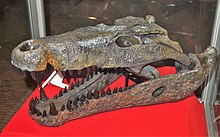| Quinkana | |
|---|---|

| |
| Restoration of the skull of Q. timara at the Central Australian Museum | |
| Scientific classification | |
| Domain: | Eukaryota |
| Kingdom: | Animalia |
| Phylum: | Chordata |
| Class: | Reptilia |
| Clade: | Archosauromorpha |
| Clade: | Archosauriformes |
| Order: | Crocodilia |
| Clade: | †Mekosuchinae |
| Genus: | †Quinkana Molnar, 1981 |
| Type species | |
| †Quinkana fortirostrum Molnar, 1981
| |
| Species | |
| |
Quinkana is an extinct genus of mekosuchine crocodylians that lived in Australia from about 25 million to about 10,000 years ago, with the majority of fossils having been found in Queensland. Four species are currently recognized, all of which have been named between 1981 and 1997. The two best understood species are Q. fortirostrum, the type species, and Q. timara, a more gracile form from the Miocene. The other two species, Q. babarra and Q. meboldi, from the Pliocene and Oligocene respectively, are only known from a few poorly preserved bone fragments. The name Quinkana comes from the "Quinkans", a legendary folk spirit from Gugu-Yalanji mythology.
Quinkana is primarily known for its ziphodont teeth, meaning they were recurved, serrated and possessed flattened sides that gave them a blade-like shape. However, technically such teeth are only known from two species, as the basalmost form lacked serrations while the holotype of Quinkana fortirostrum did not preserve teeth in its alveoli. The genus is distinguishable by the combination of these ziphodont teeth and a deep, altirostral skull that is sometimes compared to those of sebecosuchians and planocraniids, leading some early researchers to mistakenly assign Quinkana to said groups. Quinkana is typically estimated to be around 3 m (10 ft) in length and to weigh around 200 kg (440 lb), though some remains from the Pliocene could suggest an even greater size. However, these estimates are based on fragmentary specimens and dimensions of related genera as there have been no complete Quinkana specimens found.
The genus has been argued amongst paleontologists to be either terrestrial or semi-aquatic, with both sides providing a variety of arguments. Academic analysis cites comparative morphologies as indicators of Quinkana’s habitation to be terrestrial, commonly comparing the anatomy of the crocodilian to other, more definitively terrestrial crocodylomorphs from the Mesozoic and early Cenozoic. The discovery of pelvic bones that belonged to a crocodilian with a pillar-erect stance in the same strata as Quinkana also support this line of thinking, even though no clear overlap to confirm this hypothesis exists. While the majority of mekosuchine researchers support the idea that Quinkana was terrestrial, some counter arguments have been raised in the past, especially highlighting that Quinkana is still consistently found to have lived near freshwater. The role Quinkana filled in the ecosystems of Late Pleistocene Australia has also been a matter of debate, with older literature in particular often claiming that the continent was dominated by reptilian predators. Opponents of this hypothesis meanwhile highlight how Quinkana was relatively rare, whereas large marsupial predators like Thylacoleo were much more common.
Regardless of its lifestyle and behavior, Quinkana is predominantly found in sediments preserving various types of woodland in proximity to bodies of water such as ponds, streams and billabongs. Though successfully surviving a drastic arid period that marked the transition from the Late Miocene to the Early Pliocene, Quinkana would eventually die out towards the end of the Pleistocene, with estimates suggesting that it died out somewhere between 40.000 and 10.000 years ago. The precise reasons for Quinkana's disappearance are unknown, but it is hypothesized that another period of intense aridification gradually dried up the river basins and destroyed the forests that the crocodilian inhabited, leading it to go extinct alongside much of Australia's megafauna. Humans, which arrived on the continent around the same time, were likely not responsible for this chain of events.